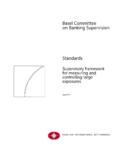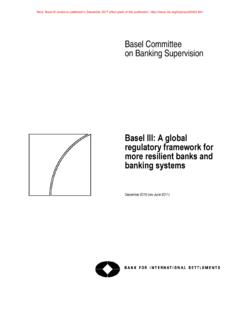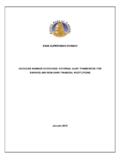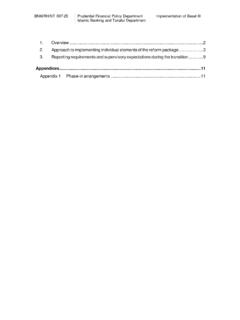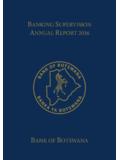Transcription of The Impact of Basel III on Commodity Trade …
1 The Impact of Basel III on Commodity Trade finance : legal And regulatory aspects By Gilles Thieffry Reprinted from JIBLR Issue 9, 2011 Sweet & Maxwell 100 Avenue Road Swiss Cottage London NW3 3PF (Law Publishers) * legal Analyses 455 legal ANALYSES The Impact of Basel III on Commodity Trade finance : legal And regulatory aspects Gilles Thieffry banking supervision ; Commodity markets; International standards; Risk management Basel III overview In the aftermath of the financial crisis of 2008, governments felt it necessary to toughen capital standards for the banking industry.
2 The implementation of the international capital requirements framework agreed by the Basel Committee on banking supervision , known as Basel II, had barely been implemented when the financial crisis occurred (and it was not implemented in all Member Countries, notably the United States), that it was felt necessary to amend and strengthen Basel II in the light of the crisis. This is what is known as Basel III. Basel III is part of the Committee s continuous effort to enhance the banking regulatory framework. It builds on the Basel I and Basel II documents, and seeks to improve the banking sector s ability to deal with financial and economic stress, improve risk management and strengthen the banks transparency.
3 Two documents: Basel III: A Global regulatory Framework for more resilient banks and banking systems and Basel III: International Framework for Liquidity Risk Measurement, Standards and Monitoring present the Basel Committee s reforms to strengthen global capital and liquidity rules with the aim of promoting a more resilient banking Basel III establishes tougher capital standards through more restrictive capital definitions, higher Risk Weighed Assets ( RWA ), additional capital buffers, and higher requirements for minimum capital ratios.
4 Primary sources for RWA increases include trading market risk, securitisation exposures and over-the-counter ( OTC ) derivatives counterparty exposure. As well as rethinking their business models, many banks will need to achieve upgrades in the areas of stress testing, counterparty risk, and capital management infrastructure. Basel III also establishes new liquidity standards that will drive changes in banks balance sheet composition to limit illiquid assets, restrict wholesale or unstable sources of funding, and manage higher funding costs. These new standards will have a broad Impact across most banks, particularly those that focus on commercial and wholesale banking activities.
5 At the heart of the financial crisis that we lived through was liquidity. Basel III requires: a) more assets to be of a high quality liquid nature (like cash and highly rated government bonds); and b) more of the wholesale funding to be of a long dated and stable nature, so as to minimise the risk of having to renew it at times of stress. Basel III s increased capital and liquidity requirements will have significant systemic and idiosyncratic effects across the banking industry and capital markets. Higher capital and funding costs should incentivise banks to move toward different business models. Some examples of anticipated changes and opportunities include: 1.
6 Shrinkage of securitisation market and structured credit businesses putting pressure on originate-and-sell lending businesses. 2. Reduced volumes in OTC derivatives and migration to clearing houses. 3. Emphasis in customer facilitation activities with reduction of trading inventories particularly of less liquid assets such as low credit quality, Commodity and emerging market instruments thus reducing the liquidity of those market segments and resulting in block trading opportunities. 4. Expansion of businesses dedicated to Trade clearing, Trade processing and servicing. 5. Transfer of proprietary trading to hedge funds.
7 6. Increased competition from less regulated firms and potential loss of human capital to new entrants. 7. New structuring opportunities for banks considering contingent capital instruments. 8. Pricing strategies will be altered in those businesses that over the medium term are not able to deliver acceptable returns. For many institutions, Basel III s liquidity challenge is likely to be greater than its capital challenge. In anticipation of the Basel III Impact on liquidity, firms are likely to reduce the number of their businesses with an * Solicitor (England and Wales), Member of the New York bar, Avocat au Barreau de Paris.
8 Partner GTLaw, Geneva 1 Basel III: A Global regulatory Framework for more resilient banks and banking systems, publication, BIS, December 16, 2010 available at [Accessed June 24, 2011]. [2011] , Issue 9 2011 Thomson Reuters (Professional) UK Limited and Contributors 456 Journal of International banking Law and Regulation unfavourable liquidity treatment; raise the liquidity of their investments; raise their retail deposits; increase their additional long-term debt and capital; reduce their committed credit and liquidity facilities; reduce their wholesale credit; and adjust their pricing to compensate for the higher cost of funding.
9 In its October 2010 report, G20 Leaders made recommendations on implementing OTC derivatives market reforms, set out actions and timelines for achieving reforms in the OTC derivatives markets and also considered what future work may be needed on Commodity derivatives. The Financial Stability Board ( FSB ) will consider recommendations regarding Commodity derivatives market regulation and supervision in the context of the agreed reforms to OTC derivatives markets more generally, and IOSCO will deliver a final report on supervision and regulation of Commodity derivatives markets by the autumn.
10 The national implementation of Basel III by the Member Countries will begin from January 1, 2013. As part of this implementation, banks in each of the Member States should meet the following new minimum requirements in relation to RWA: per cent Common Equity/RWAs; per cent Tier 1 Capital/RWAs; and per cent Total Capital/RWAs. In summary form, the following table sets out the major differences between Basel II and Basel III: Basel II: A. Tier Capital Tier 1 capital ratio = 4% Core Tier 1 capital ratio = 2% The difference between the total capital requirement of and the Tier 1 requirement can be met with Tier 2 capital.
